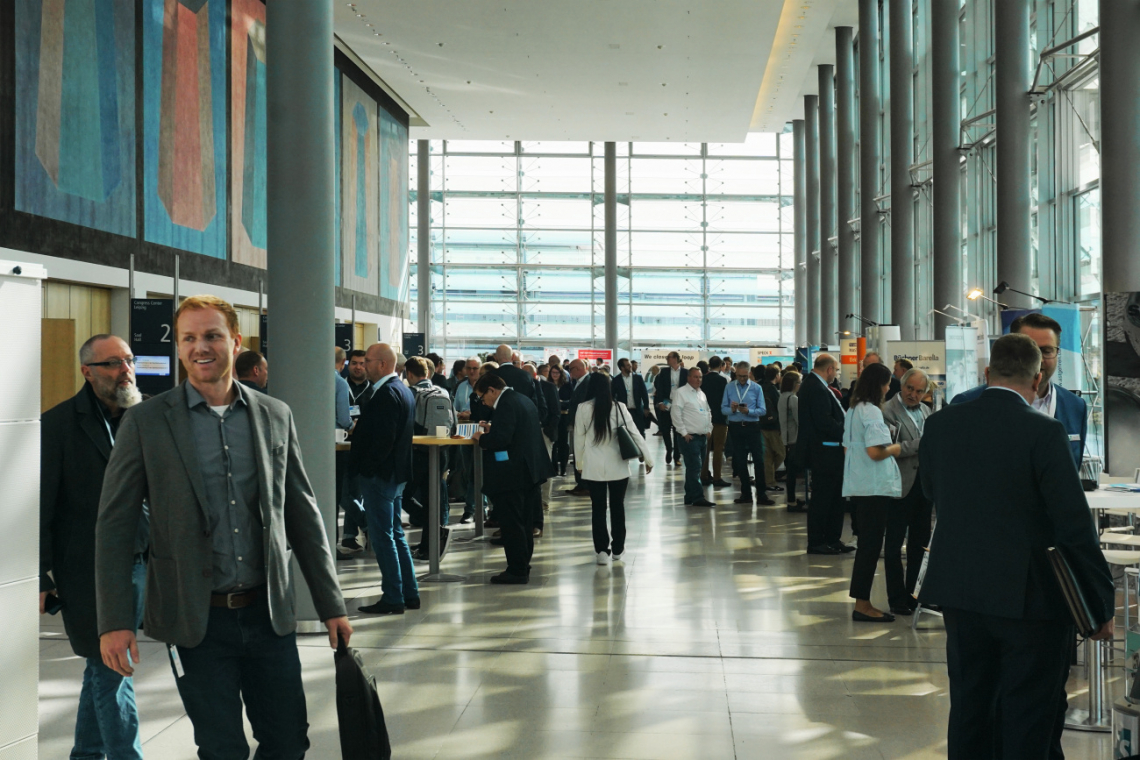ZVO Surface Days 2024, energy, carbon footprint and material efficiency - Part 2 -
On the opening evening, DGO Chairman Dr Martin Metzner got the participants in the mood for the mix of topics including material and energy efficiency, coating technology and sustainability, hydrogen economy and electrification as well as digitalization. The next day saw the start of a marathon of almost 100 presentations. Part 2 of our reporting focuses on energy, carbon footprint, material efficiency and digitalization. Assessments from industry participants on the future of electroplating in the margins of the report also give an impression of the mood at the conference.
Session 2 presented ways in which companies can save energy and thus reduceCO2 emissions. The first step is always to carry out an analysis of the current situation in order to identify potential savings. Based on this, effective climate protection measures can be derived. In many cases, investments to implement the measures can be subsidized. The presentations also provided tips on how to successfully master the not always easy procedure from application to approval.
Energy, carbon footprint and material efficiency
 There was plenty to choose from. Participants get a picture (Photo: ZVO/Sven Hobbiesiefken)Michael Schem, MacDermid Enthone Industrial Solutions, presented sustainability aspects of sealing. He described the approach to developing sealants with bio-based solutions based on renewable raw materials. Possible conflicts exist in the competition with foodstuffs, with only around 2% of agricultural land in Germany currently being cultivated for industrial crops. The largely bio-based sealant offers good corrosion protection with coefficients of friction of 0.1 to 0.15 as well as a visually flawless surface and is competitively priced. However, it does not yet meet the requirements of the automotive industry. The addition of biocides prevents the formation of mold in the sealant, so that a good service life is possible.
There was plenty to choose from. Participants get a picture (Photo: ZVO/Sven Hobbiesiefken)Michael Schem, MacDermid Enthone Industrial Solutions, presented sustainability aspects of sealing. He described the approach to developing sealants with bio-based solutions based on renewable raw materials. Possible conflicts exist in the competition with foodstuffs, with only around 2% of agricultural land in Germany currently being cultivated for industrial crops. The largely bio-based sealant offers good corrosion protection with coefficients of friction of 0.1 to 0.15 as well as a visually flawless surface and is competitively priced. However, it does not yet meet the requirements of the automotive industry. The addition of biocides prevents the formation of mold in the sealant, so that a good service life is possible.
Joachim Ramisch, Riesmetall, Nördlingen
" I see a great future for electroplating, because electroplating is used everywhere where wear, corrosion and consumer goods are concerned. Civilization without electroplating is unimaginable "
Norbert Fessler, safedry, discussed the technical and economic aspects of drying. The most important elements of a dryer are the fans with waste heat utilization, heating, insulation, lid, droplet separator and controlled air dehumidification. The modern technology from safedry reduces the energy requirement by half. Thanks to a subsidy for the investment in the dryer, the best drying results so that no additional manual work is required for cleaning and polishing the parts, and the lower energy costs, the efficient system pays for itself very quickly.
Harter GmbH also offers a very energy-efficient drying system. Reinhold Specht presented the heat pump-based condensation drying system, which can save up to 85% energy. Depending on the component, drying takes place in the temperature range from 40 to 77 °C. Customers receive customized systems. These are adapted to the respective product and process requirements in the technical center by means of drying tests. Both rack and drum products can be dried. The process is also suitable for sludge drying in order to reduce expensive disposal costs. The speaker also recommended applying for a BAFA subsidy to reduce investment costs.
Lars Baumgürtel, Zinq, Gelsenkirchen
" Surface technology is exciting because it has so much potential for innovation. It makes a significant contribution to extending the service life of products, and this is of course an absolute basis for achieving the goals of the Green Deal, the circular economy, so that the energy transition and climate neutrality can succeed "
Jens Krümberg, Eilenburger Elektrolyse- und Umwelttechnik GmbH, reported on a process for recycling pickling solutions with sodium peroxodisulphate in PCB production. The sodium peroxodisulphate pickling solutions used for fine pickling must be replaced with fresh pickling solution from a copper concentration of 20 g/L so that the desired pickling effect does not diminish. During electrolytic treatment, the enriched copper is cathodically deposited and the sodium peroxodisulphate, which has been reduced to sodium sulphate, is reoxidized so that the pickling solution can be used again. Very good results were achieved with a diamond-coated anode.
The volume of waste water from the discarding of rinsing water can be reduced by recycling rinsing water. Eckart Giebler, Collini GmbH, has presented a mathematical model with which the recirculation from the first rinse into the process solution can be calculated as a function of the evaporation in the process solution, the drag-out and the rinse water concentration. Rinsing water recirculation also returns bath ingredients to the process solutions, which minimizes material losses. The metal concentration depends on the anodic and cathodic current density. If metal concentrations increase, the recirculated rinse water volume flow is throttled and part of the rinse water is fed into the waste water treatment system. In order to reduce metal losses, the speaker recommends reducing the difference between the anodic and cathodic current density. The model is currently being published in a three-part series in Galvanotechnik: in issue 10, in this issue 11 (more from p. 1420) and in the upcoming issue 12.
The chromium(III) electrolytes used as an alternative to the tried-and-tested chromium(VI) electrolytes are more expensive and more complex to operate. Christian Kurrle, Umicore Galvanotechnik GmbH, and Marvin Wagner, BIA Kunststoff- und Galvanotechnik GmbH & Co. KG, spoke about their experiences of chrome plating with chromium(III) electrolytes from the perspective of the electrolyte manufacturer and the electroplater. The anode design plays a key role in the process. Very good results were achieved with iridium-coated titanium anodes. Open titanium surfaces and cut edges on the anode must be avoided in order to prevent the formation of chromium(VI) in the electrolyte. Due to the high price of iridium, the protective layer should be as thin as possible. Therefore, a topcoat was developed that protects the iridium layer and allows thinner iridium layers, reducing costs by 25 %. Anode recycling will be investigated in the near future.
Patricia Preikschat, presch matters GmbH, gave an overview of efficiency and sustainability in electroplating technology. The basic idea of sustainability is the benefit for everyone involved. The lack of verifiability of sustainability is still difficult. A first step is to draw up a corporate carbon footprint in which theCO2 emissions are listed. Examples of reducedCO2 emissions in electroplating companies show what companies can do themselves. Franz Rieger, for example, has installed PV roof systems since 2011, switched to pure green electricity, introduced electromobility and electrified its heat supply. Specialist companies are also facing up to their responsibilities and offering chemicals that can be dosed separately, thereby reducing the amount of chemicals required. Formulations are also being changed by using additives made from renewable raw materials.
Dr. Elke Spahn, Gravitech, Rodgau
" The future of electroplating technology depends on Germany. We must be careful not to give away our know-how and remember that we are an engineering society and that we do not live from our natural resources, but from our knowledge. And the level of knowledge in electroplating technology is very high compared to other countries "
Patrik Lammert, pur4mance GmbH, and Michael Dallmayer, Dallmayer Galvano-Consulting, spoke about the practical implementation of guidelines and laws to reduceCO2 emissions using the example of electroplating. Every company is required to draw up aCO2 balance sheet by 2027. The data situation is difficult. The speakers advised against relying solely on secondary data from databases when creating the footprint. It would be better to carry out a process simulation for greater accuracy. For thecarbon footprint, peripheral devices such as pumps, exhaust air systems, air scrubbers, waste water treatment with filter presses, collection and treatment containers as well as cooling, heating, dryers etc. must also be evaluated. The data can then be used to identify deficits and define measures for energy savings. For a detailed life cycle assessment in small companies, they recommend external support.
CO2 is the currency of the future, as Stephan Krinke, Fraunhofer Institute for Surface Engineering and Thin Films IST, emphasized. Decarbonization is the central topic for the sustainability strategy of many companies. The drivers are sustainability ratings, financial markets and the statutory CSRD (Corporate Sustainability Reporting Directive), which requires a plan of action for climate protection. Small companies will also have to report in accordance with CSRD from 2026. The entire value chain must be considered when preparing the sustainability assessment. The speaker also recommended seeking support from external experts. The Fraunhofer Institute IST offers tailor-made tools and consulting services for the decarbonization of surface technologies. These include carbon footprints, hot-spot analyses andCO2 avoidance cost curves.
Frank Tischlinger, TBK Solingen
" The future of electroplating is under threat without trainees. At the moment, business areas in the automotive and decorative sectors are disappearing. This will hopefully stabilize again, but even then we will lack the manpower again, similar to 2008, when there was no more training and later a lack of skilled workers "
Adolphe Foyet, DuPont, presented a new high-speed tinning process for matt coatings. Surface technologies have to meet ever higher demands. Therefore, chemical additives for high-speed tinning processes have been developed to meet the requirements of environmental compatibility, low whisker formation and best corrosion resistance for electronic components, thus offering higher reliability and performance. The high-speed tinning process operates with high productivity over a wide current density and temperature range. A lower operating temperature enables savings in energy costs. In addition, a non-toxic antioxidant improves both the chemical stability and the sustainability of the product (see also the article by Adolphe Foyet in the Leuze online magazine JEPT at https://t1p.de/u6q65).
Digitalization in surface technology
The use of modern, AI-supported automation technology can also increase the performance of existing systems, as Andreas Scholz and Florian Wimmenauer, Aucos AG, reported. The coating and system peripherals are controlled using software specially tailored to the customer. Simulated process sequences for system planning minimize commissioning times. In day-to-day operations, quality management, component inspection, rack management and logging are also simplified by the production control system with special solutions. This enables the productivity of the systems to be increased efficiently.
 Günter Schmitt from the IFINKOR Institute spoke about zinc-nickel, an important electroplating layer in the automotive industry. Online control significantly improves the process and process reliability (Photo: ZVO/Sven Hobbiesiefken)
Günter Schmitt from the IFINKOR Institute spoke about zinc-nickel, an important electroplating layer in the automotive industry. Online control significantly improves the process and process reliability (Photo: ZVO/Sven Hobbiesiefken)
Günter Schmitt, IFINKOR-Institut für Instandhaltung und Korrosionsschutztechnik gGmbH, spoke about electrochemical control of the degreasing, pickling and passivation process steps in the galvanic production of ZnNi coatings. Process control via transients of the free corrosion potential (FCP) is very suitable for this. The metal product to be treated is contacted as an electrode and its potential transient is measured against a reference electrode when it is immersed in the process solution. The end of the treatment, for example degreasing, is reached when the FKP transient reaches a stationary level of dU/dt < 0.02 mV/s. When the criterion is reached, optimum hydrophilicity of the metal surface is also achieved, which is advantageous for the subsequent process steps. This form of online control enables shorter treatment times, less hydrogen embrittlement during pickling, longer service life of the process solutions and an increase in process reliability with the highest quality.
Sebastian Breuckmann, DiTEC Dr. S. Kahlich & D. Langer GmbH, gave an insight into possible optimization potentials for electrolyte management in order to save costs and improve quality. The ProGal control system intelligently analyzes, optimizes and controls all processes related to the surface treatment system. Various modules are integrated into the control system. The bath analysis module calculates the additives based on the analysis. With the interface to the control system, the analyses are carried out depending on the product throughput.
Richard Utikal, Utikal Automation, Achstetten
" Electroplating technology must change and become more customer-oriented. The processes should be geared towards the customer and specialized. I see this in my customers: The specialized ones are doing well in contrast to those who offer mass-produced goods "
Digitization represents an opportunity for companies to achieve greater economic benefits. Throughput times can be reduced through better plant utilization, costs lowered and quality improved. Data and data availability are the basis of digitized electroplating technology, as Peter Schwanzer, Fraunhofer Institute for Manufacturing Engineering and Automation IPA, emphasized. Merging the recorded machine, production, order, process and analysis data enables good forecast values in the process, which can improve electrolyte quality, for example. A solid database is also very useful for planning conversion measures in the energy system of the heat and power supply. In the IPA's learning electroplating department, experience has been gained in electrolyte control with the support of machine learning. Interested parties and partners are still being sought for the scaling and application of the various approaches in an industrial environment and for the development of new approaches.
 Rowena Duckstein (pictured), Fraunhofer IST, and Marija Lindner, TU Braunschweig, presented AI-based inline measuring devices for surface technology (Photo: Fraunhofer IST)
Rowena Duckstein (pictured), Fraunhofer IST, and Marija Lindner, TU Braunschweig, presented AI-based inline measuring devices for surface technology (Photo: Fraunhofer IST)
Rowena Duckstein, Fraunhofer Institute for Surface Engineering and Thin Films IST, and Marija Lindner, TU Braunschweig, presented AI-based inline measuring devices for surface technology. Expensive chemical analyses that would otherwise be necessary are to be replaced by AI-based data evaluation. For example, the AI-based data evaluation makes predictions for the metal concentrations and the layer thicknesses to be achieved. In addition, the chemical and process parameters are modeled in order to optimally dose chemicals in the electrolyte and adapt the process to changing requirements.
Tim Bolder, Moosbach & Kanne, Solingen
" Electroplating is and will remain a specialist area that is an integral part of everyday life, even if it is often hidden from the public eye. The difficulty will be to deviate from conventional schemes and ways of thinking and to see that we do not operate this specialist area wastefully, but sustainably, i.e. not always reproducing, but also reworking "
Arnaud Kropp, Softec GmbH, presented how digitalization can be implemented in the everyday life of galvanic companies. With the software presented, the user knows where the goods are in the production process, from goods delivery to goods issue. Current production information is displayed via tablets, smartphones or production screens. Analysis values and measurement logs can also be digitized directly.
Management meets surface - sustainable and climate-neutral electroplating
On the one hand, galvanic surface treatment prevents corrosion and wear damage, thereby conserving resources. On the other hand, it requires chemicals and energy. Production costs can be reduced by using fewer chemicals and less energy, which also improves the sustainability of companies. Medium-sized companies will soon also have to prepare sustainability reports. In this session, examples were given of howCO2 emissions can be reduced by optimizing the use of energy. Advice was also given on forward-looking investments.
 The efficient use of exhaust air and heat recovery was the topic of Christian Deyhle from Qubus Planung und Beratung Oberflächentechnik GmbH (Photo: ZVO/Sven Hobbiesiefken)
The efficient use of exhaust air and heat recovery was the topic of Christian Deyhle from Qubus Planung und Beratung Oberflächentechnik GmbH (Photo: ZVO/Sven Hobbiesiefken)
Christian Deyhle, Qubus Planung und Beratung Oberflächentechnik GmbH, used the example of optimized heat recovery from exhaust air to show what climate-neutral electroplating could look like in the future. Exhaust air is a significant source of heat in existing electroplating plants. According to the Energy Efficiency Act (EnEfG), companies with an average total energy consumption of more than 2.5 GWh/year over the last 3 years are obliged to record waste heat sources and identify measures to avoid or utilize waste heat. The heat can be used by integrating a heat exchanger, a heat pump to optimize the heat recovery system and for process cooling or by using two-stage heat pump systems to use the waste heat to heat the processes.
The path to climate neutrality poses particular challenges for SMEs, as Elke Moosbach, Moosbach & Kanne GmbH, was able to report from her own experience. By investing in efficient rectifiers, a combined heat and power plant, switching to LED lighting, heat recovery and a photovoltaic system, her company has reduced itsCO2 emissions by 45%. In order to access subsidies in the funding jungle, she recommends external support - for example from your house bank. In this way, investments in individual measures, such as solar systems or heat pumps, can be subsidized.
Julius Gröne, Saueressig Group, Mönchengladbach
" I say the future looks bright! If we stop thinking about the future, it will be over. We will also need electroplating technology, just think of the collapsed bridge in Dresden, where corrosion protection is also a local issue, our very own topic. The technologies of the future also all have something to do with electroplating "
Resilience is not just the ability to withstand upheavals caused by new social, economic or political conditions, but also the ability to adapt to new conditions. Modern electroplating companies should use resilience as a strategic factor for sustainability. Edgar Kaufmann, B+T Oberflächentechnik GmbH, used various factors as examples to explain how crisis management can work. When stocking up on chemicals, the minimum and maximum stocks should be redefined. It is also advisable to expand the sources of supply. Energy monitoring is used to control and regulate energy requirements. Digital order planning helps to utilize the systems in such a way that power peaks are avoided.














